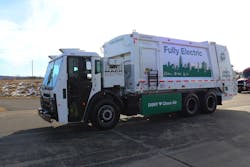First impressions after driving Mack’s electric refuse truck
I had never driven a refuse truck prior to my journey to the wooded hills south of Allentown, Pa.
Piece-of-trash cars, for sure. But never a rumbling, thundering boxy garbage truck. That list has now grown by two — the diesel-powered Mack LR Model and the brand new LR Electric — so of course I have some pretty strong opinions on the matter.
First off, driving a garbage truck on a mostly vacant test track was harrowing enough due to sightlines and physics. But to lurch forward, then stop every 15 feet or so, get out and handle who-knows-what that’s in those bins and bags, and hop back in and repeat? It takes a very specific truck and a very patient type of person to pull that off safely day in and day out.
Mack’s engineers designed the chassis for the LR Model, the first truck I tested, to make that job easier with customizable door options and driver configurations. The one on the track that chilly January morning in the Lehigh Valley had dual steering columns, which for today’s purpose I initially inferred allowed the Mack representative to take the wheel if one of the trucking media members made a grave miscalculation in turning angle relative to speed.
There would be no such worry with me behind the driver’s side wheel, as I was intent on not pushing the lumbering beast past a brisk 20 mph. In my defense, there was a family of deer doing wind sprints along the track all day, not to mention accelerating, braking and overall handling took a bit of time to get used to. So the 11L MP7 engine didn’t get as much of a workout.
It did provide me a good baseline for the real reason Mack Trucks invited the media to its customer center and test track, which was to try out the LR Electric. In a few days, Mack would deliver the zero-emissions truck to the City of New York Department of Sanitation (DSNY) to run a few practice routes in Brooklyn before taking the truck to Mack’s Greensboro, N.C. plant to make adjustments and changes based on DSNY feedback.
I had watched Rocky DiRico, DSNY's deputy commissioner, and my fellow journalists take turns zooming off in the LR Electric from the muster point all morning. Each time I was struck with how quiet the vehicle was. I think I make more noise pulling my plastic receptacles over my driveway to the curb.
When I climbed up and got in myself, I realized it was a bit noisier on the inside. There was intermittent squeaking and rubbing due to all the mechanical parts and the seat bouncing up and down (I had adjusted my seat so I could reach the pedals). It sounded a bit like a hyena nervously laughing at an inappropriate joke, but the engine never reached above a polite hum.
The residents of Brooklyn would certainly appreciate that versus the roar of a diesel truck early in the morning, I thought.
The reduction in noise pollution is a bonus, as the true benefit to the community is taking one less CO2-emitting truck off the road. NYC Mayor Bill de Blasio aims to reduce greenhouse gas emissions by 80% by the year 2035 and have the Big Apple carbon neutral by 2050.
The LR Electric is powered by four NMC lithium-ion batteries (Lithium Nickel Manganese Cobalt Oxide). They take about 90 minutes to charge, and the grid they draw from comprises a mix of mostly natural gas, nuclear and hydroelectric power. The other 10% comes from “other non-hydroelectric renewable resources,” according to the U.S Energy Information Administration.
While the pickup was quite impressive, and the electric version was much more amenable to a rookie driver, the truck’s built-in recycling plant, the regenerative braking system, was my favorite feature. Along with the electric powertrain, it made the truck easier to stop, and thus instilled more confidence in this driver.
Typically, when a body in motion stops, the energy used to create that momentum just flitters away. With regenerative braking, that kinetic energy transfers to devices near the axles. Like water falling and propelling a turbine, they are activated by resistance, generating a modest amount of electrical energy that is channeled back to the batteries.
They also spare the brakes from the full burden of stopping 75,000 lbs. over and over.
“Regenerative braking should be a big contributor to reduced brake wear, which is a major expense for any refuse operation,” explained Scott Barraclough, Mack's technology product manager.
He also mentioned the total cost of ownership (TCO) will be greatly reduced, as the DSNY mechanics don’t have to worry about engine oil change intervals.
NYC won’t likely see more of these on the road until mid-spring, and even then only a handful will be used. But the major takeaway is that electric work trucks aren’t just an environmentalist fantasy now. They are starting to prove they can appease tighter emissions rules while potentially saving fleets money in the process.
The DSNY reps were bubbling at how well the truck performed and the potential for slashing fuel and maintenance costs. They should know, as they have a fleet of more than 6,000 trucks overall and several decades of experience.
For what it’s worth, out of the two I have driven, I also prefer the LR Electric. Time will tell if fleets agree, but this truck is off to a great start.
About the Author
John Hitch
Editor
John Hitch is the editor-in-chief of Fleet Maintenance, providing maintenance management and technicians with the the latest information on the tools and strategies to keep their fleets' commercial vehicles moving. He is based out of Cleveland, Ohio, and was previously senior editor for FleetOwner. He previously wrote about manufacturing and advanced technology for IndustryWeek and New Equipment Digest.

